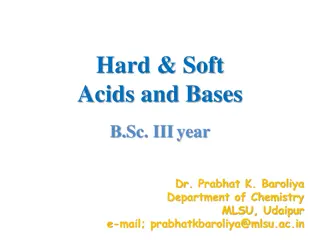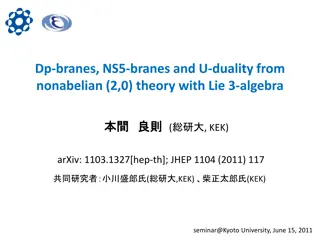Understanding Hard & Soft Acids and Bases in Chemistry
Explore the concepts of hard and soft acids and bases in chemistry, including the Arrhenius, Brønsted-Lowry, Lewis, and Solvent System models. Learn about the HSAB principle introduced by R.G. Pearson, discussing polarizing power and polarizability of acids and bases. Understand how these principles apply to oxide and sulfide ores in various metal compounds.
Download Presentation

Please find below an Image/Link to download the presentation.
The content on the website is provided AS IS for your information and personal use only. It may not be sold, licensed, or shared on other websites without obtaining consent from the author. Download presentation by click this link. If you encounter any issues during the download, it is possible that the publisher has removed the file from their server.
E N D
Presentation Transcript
Hard & Soft Acids and Bases B.Sc. IIIyear Dr. Prabhat K. Baroliya Department of Chemistry MLSU, Udaipur e-mail; prabhatkbaroliya@mlsu.ac.in
Acids and Bases Arrhenius acids form hydronium ions (H3O+), and bases form hydroxide ions (OH-) in water. Br nsted and Lowry expanded the Arrhenius definitions, and defined acids as proton donors and bases as proton acceptors.
Acids and Bases Br nsted and Lowry Model They also introduced the concept of conjugate acid-base pairs.
Acids and Bases Lewis Model acids are electron pair acceptors and bases are electron-pair donors. It also works with molecules that neither give up nor accept a hydrogen ion
Acids and Bases Solvent System Model This model was developed for solvents that can dissociate into cations (acid) and anions (base).
Hard & Soft Acid-Base model Observation Oxide ores Sulfide ores Aluminium-Bauxite---Al2O3 Iron-Hematite---Fe2O3 Mercury-Cinnabar---HgS Silver-Argentite---Ag2S Why?
Hard & Soft Acid-Base model R G Pearson introduced the hard & soft-acid-base (HSAB) principle. The polarizing power and polarizability of an acid or base play important role in its reactivity. Hard acids and bases are small, compact, and non-polarizable. Soft acids and bases are larger, with a more diffuse distribution of electrons.
Polarizing power & Polarizability The polarizing power can be defined as the ability of a cation to attract electron cloud towards itself. It is proportional to Charge/Size. M+ M+
Polarizing power & Polarizability The polarizability is the ability to form instantaneous dipoles. OR It is measure of how easily an electron cloud is distorted by an electric field or nearby cation or anion. Polarizability M+ M+ Polarizing power
HSAB According to HSAB principle, the Lewis acids and bases can be further divided into hard or soft or borderline types. Hard Acids prefer to bond with Hard Bases, and Soft Acids prefer to bond with Soft Bases.
Hard Acids and Base Hard acid: High positive charge Small size High polarizing powder Not easily polarizable Hard base: Small size Low polarizability High electronegativity
Soft Acids and Base Soft acid: Low positive charge Large size low polarizing powder High polarizablity Soft base: Large size High polarizability Low electronegativity
Hard and Soft Acids-Base Hard acids or bases are small and non- polarizable. Soft acids and bases are larger and more polarizable Halide ions increase in softness: fluoride < chloride<bromide<iodide Hard-hard or soft-soft interactions are stronger than hard-soft interactions.
Hard and Soft Acids-Base Classification
Hard and Soft Acids-Base Ionic bond Covalent bond According to HSAB concept, hard acids prefer binding to the hard bases complexes. whereas the soft acids prefer binding to soft bases to give covalent complexes. to give ionic























